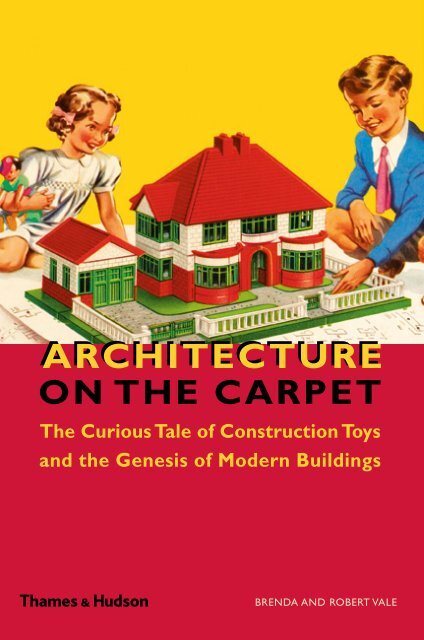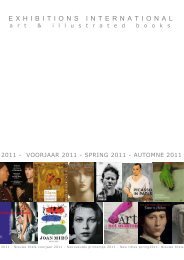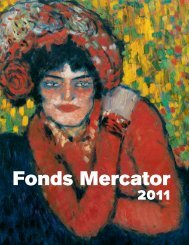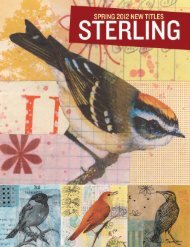pdf 1 - exhibitions international
pdf 1 - exhibitions international
pdf 1 - exhibitions international
You also want an ePaper? Increase the reach of your titles
YUMPU automatically turns print PDFs into web optimized ePapers that Google loves.
arChiTeCTure<br />
on The CarpeT<br />
The Curious Tale of Construction Toys<br />
and the Genesis of Modern Buildings<br />
Brenda and roBert Vale
contents<br />
introduction Toys Are Us 7<br />
chapter one Modernism on the Line 9<br />
chapter two Richter’s Blocks and the Castles on the Rhine 24<br />
chapter three Meccano and Making Visible How Things Work 38<br />
chapter four Lott’s Bricks and the Arts and Crafts Movement 51<br />
chapter five Wenebrik and the (Un-modern) Steel House 64<br />
chapter six Lincoln Logs and the Log Cabin 77<br />
chapter seven Mobaco and De Stijl 89<br />
chapter eight Bayko and Suburbia 99<br />
chapter nine Minibrix and Unassuming Architecture 111<br />
chapter ten Juneero and the Architecture<br />
of Make-Do-and-Mend 127<br />
chapter eleven Castos and Concrete on the Carpet 136<br />
chapter twelve Bilt-E-Z, Girder and Panel, Arkitex<br />
and the Brave New World 150<br />
chapter thirteen Playplax and Deconstruction 164<br />
chapter fourteen Lego and the Green City 176<br />
chapter fifteen Learning Architecture on the Carpet 189<br />
Notes 191<br />
Picture Credits 204<br />
Acknowledgments 204<br />
Index 205<br />
This sales blad contains uncorrected proofs<br />
of sample pages. The full specification for the<br />
book itself is:<br />
Trimmed page size: 22.9 x 15.2 cm<br />
hardback with jacket<br />
208 pages with 111 illustrations, 97 in colour<br />
ISBN 978-0-500-34285-5 £19.95<br />
(price subject to change without notice)<br />
Thames & Hudson<br />
181A High Holborn, London WC1V 7QX<br />
www.thamesandhudson.com
introduction<br />
Toys<br />
Are<br />
Us<br />
If, according to WordsWorth, ‘the child is father of the man’ 1<br />
does the construction toy therefore make the architect? If you played with<br />
Meccano (British but with many copies all over the world) do your buildings<br />
have a prefabricated engineered appearance with lots of holes in bits of the<br />
structure? If you played with Girder and Panel (American but with a British<br />
copy) are your buildings typical of so much commercial architecture, high-rise<br />
blocks with frames clad with panels of glass and sometimes solid material?<br />
In the middle of the nineteenth century a group of architects emphasized<br />
the importance of the learning environment to a child’s development, stating<br />
that what was experienced then would be ‘carried to the end of life’. 2 Designers<br />
of educational toys from Friedrich Froebel with his famous blocks3 to Hilary<br />
Page, an early user of plastic for toys and a man who could have claimed to have<br />
invented Lego, 4 have also built reputations on the idea that their toys would form<br />
the mind of the child in the best possible way. This book tries to look for similarities<br />
between what you can build with a selection of construction toys and the<br />
architecture that these seem to represent best, as well as being an excuse to have<br />
a lot of fun playing with them.<br />
The toy industry is <strong>international</strong>. Just as modern architecture spread from<br />
the beginning of the twentieth century to become almost an instrument of globalization,<br />
so toys could also claim to be a unifying factor in the spread of ideas.<br />
Germany started the trend with the successful Richter’s Blocks, but American<br />
Lincoln Logs and their many imitators have also ensured children around the<br />
world can build log cabins on the carpet, and even good old British Meccano was<br />
made under licence as far away as Argentina. While it is of course not quite true<br />
that the whole course of modern architecture was set by the construction toys of<br />
the modern period, as early as the 1920s Bilt-E-Z, an American metal toy, could<br />
be used to construct the iconic stepped-back skyscraper, 5 just like the 1931<br />
McGraw Hill and Empire State buildings in New York. Later, the British Arkitex<br />
mirrored the steel-framed glass towers and office blocks of the modern era.<br />
Not all construction toys looked forward to (or even sideways at) change in<br />
the built environment. Richter’s Blocks never really progressed beyond building<br />
a mythical image of medieval Germany, in America Lincoln Logs perpetuated<br />
the legend of the frontier and Wild West in its many versions of miniature log<br />
cabins, and in Britain black-and-white Tudor Minibrix were sold with a grainy<br />
photograph of seventeenth-century houses in the village of Weobley in<br />
Herefordshire, so redolent of ‘olde England’.<br />
The toys featured in this book are only a few examples of the very many<br />
different building toys that have been sold in the last hundred or so years. There<br />
are families among these toys, such as those that stack, like Richter’s Blocks,<br />
those with interlocking bricks, like modern Lego, and those with systems that<br />
bear no resemblance to how buildings are really put together, like Bayko. We<br />
have tried to pick examples of different types of construction systems, as well as<br />
toys that seem, at least to us, to have a relationship with architecture. Some<br />
excellent ones never made these pages: the 1930s French toy Assemblo made<br />
Bilt-E-Z-like stepped-back towers from metal plates that were joined by threading<br />
rods through their intersecting edges; the 1940–50 DuPage Vinylite Plastic<br />
Building Sets from Chicago made very good small, modern, flat-roofed houses<br />
that seem to have stepped straight from the pages of contemporary issues of<br />
Architectural Forum (although this was probably because the smaller sets did not<br />
come with the more expensive pitched roofs); for real Art Deco fantasies it is<br />
hard to beat the 1930s British printed-paper construction toy Samlo; and in<br />
wonderful miniature there was the 1960s Merit Toddlers Towers [sic], which<br />
stacked up to make tiny tower blocks. We hope you may be inspired to track<br />
these down and have a go with them and with the ones we feature. The great<br />
thing about architecture on the carpet is that it is so easy to have another try if<br />
your building turns out a total mess.<br />
6 Toys Are Us 7
chapter fourteen<br />
Of all the construction toys described in this book, Lego is<br />
probably the best known. There cannot be many middle-class parents<br />
over the last fifty years who do not know what it feels like to step with<br />
bare feet onto an unexpected Lego brick lying in wait on the carpet. Lego is a toy<br />
with a long history. The first Lego plastic bricks appeared in 1947, the current<br />
version in 1958, and in 2000 Lego was named ‘Toy of the Century’ by Fortune<br />
magazine in the US and by the Toy Retailers Association in Britain. 1<br />
The origins of Lego are quite complicated. The basis of Lego, in the beginning,<br />
is the interlocking brick. There were interlocking bricks in the 1930s, such<br />
as Bild-O-Brik in the US in 19342 and the British Minibrix, which we have<br />
written about in Chapter 9. These bricks offered a limited range of shapes, and<br />
had studs on the bottom that interlocked with corresponding holes in the row of<br />
bricks below. Because they are rubber, the studs on the bricks deform slightly to<br />
lock the bricks securely together.<br />
Next on the scene were the wooden American Bricks, made by Halsam, the<br />
makers of the Lincoln Logs that appeared in Chapter 6 (Halsam also made the<br />
earlier, non-studded American Brick Blocks). 3 Halsam was founded in 1917 by<br />
two brothers-in-law, Harold Elliot and Sam Goss, Jr., who combined their names<br />
to form the company’s. One source says that Harold’s son, Kip, came back from<br />
England, where he had spent time as a child in the 1940s and discovered his<br />
176<br />
Lego<br />
and the<br />
Green City<br />
favourite toy, Minibrix; he helped launch American Bricks, which were made<br />
using the machinery that Halsam used to mass-produce checkers (draughts to<br />
the British) and dominoes. 4 However, another states that the first American<br />
Bricks patent was filed in 1939, 5 so the origin is clearly disputed. Perhaps Kip’s<br />
sojourn in England was in the 1930s, rather than during the Blitz, and then the<br />
whole thing would make sense, as the American Bricks patent is clearly later<br />
than that for Minibrix. The basic wooden American Brick has eight raised studs<br />
on the top, whereas the basic Minibrix brick has two studs on the bottom, but<br />
unlike their rubber predecessors, American Bricks interlock fairly loosely. This<br />
means they are fixed in relation to one another and cannot slide around, but they<br />
do not stay together if you pick them up. This makes them a halfway house<br />
between the plain blocks of Richter’s and Lott’s and the fully interlocking blocks<br />
of Minibrix and Lego.<br />
In some ways American Bricks were a ‘green’ product. Apparently Sam Goss<br />
used to let the workers go home early on days when the factory got too hot, 6<br />
which would mark him as a green employer, or maybe they just didn’t have air<br />
conditioning; these days the lack of air conditioning might class the factory as a<br />
green building. And of course Sam’s bricks were made of wood, a natural renewable<br />
resource, just like Minibrix, which were made of natural rubber. However,<br />
the world was moving away from natural renewable resources towards plastics<br />
made from oil (and natural gas). 7 Halsam duly followed the trend, making plastic<br />
bricks called, with glorious logic, American Plastic Bricks, which were a close<br />
copy of American (wooden) Bricks8 . Both the wooden and plastic versions had<br />
cardboard windows and doors, 9 tastefully printed with curtains and blinds, 10<br />
which fitted into slots in the bricks in the same manner as the celluloid windows<br />
of Minibrix. Later the windows changed to plastic ones that could be opened.<br />
The roofs are also like Minibrix roofs, but in cardboard rather than rubber, and<br />
American Plastic Bricks had lintels, like the Minibrix ones, for spanning openings.<br />
11 When Messrs Elliot and Goss went into plastics moulding in a big way<br />
they formed a separate company called Elgo (from Elliot and Goss), 12 which<br />
seems to have taken over the manufacture of American Plastic Bricks, although<br />
the Elgo sets do not appear to have had lintels. 13 The Australian copy of American<br />
Plastic Bricks, called Bilda-Brix, did not have lintels either, but did have narrow<br />
metal strips to support the bricks over the openings. These were unconvincingly<br />
replaced by bits of cardboard in the New Zealand version of Bilda-Brix. 14 Our<br />
experience is that Bilda-Brix definitely do not interlock sufficiently to allow a<br />
Lego and the Green City 177
An early interlocking Lego-style toy: 1950s American Bricks, made<br />
of wood by Halsam in the US.<br />
An Australian interlocking plastic brick toy of the 1960s: the Bilda-Brix Three-Storey House and<br />
the Factory from Set No. 2.
finished building to be picked up. Their designs, however, look much more<br />
‘architect designed’ than the American ones.<br />
The lack of lintels implies that the Elgo plastic bricks, (like Lego, of which<br />
more later) interlocked sufficiently to hold together without lintels over the<br />
openings. Another interpretation is that you were not expected to build widespan<br />
openings, thereby dismissing one of Le Corbusier’s desired Five Points of<br />
Architecture, la fenêtre en longueur (the long horizontal window). 15<br />
Apart from the interlocking, another aspect of American Bricks is that they<br />
were designed for building cities. Indeed Halsam and Elgo made all the components<br />
of a city and its hinterland. There were American Logs out in the sticks,<br />
American Bricks (either wooden or plastic) in the suburbs, and American Skyline,<br />
an Elgo set for making skyscrapers, 16 in the Central Business District. As Halsam’s<br />
leaflet says, ‘Many families buy set after set of…Bricks – permanent models are<br />
built at small expense – eventually complete…modern cities result.’ The idea of<br />
building a city is of course a great way to sell more bricks, and thinking about<br />
sales success will bring us to Lego.<br />
But before Lego there was Hilary Page, a British toy designer who founded<br />
a company called Kiddicraft in 1932, using his savings of £100. 17 He researched<br />
and wrote on child development, and was interested in using plastics to make<br />
toys because he was concerned about small children chewing the paint off<br />
wooden toys; 18 he introduced his ‘Sensible Toys’, made of plastics, in 1937. 19 Page<br />
marketed his new Kiddicraft Self-locking Building Bricks after the Second<br />
World War, when plastics became more widespread. He applied for a patent for<br />
these in 1944 and it was granted in 1947, 20 following an earlier patent for square<br />
bricks. The Self-locking Bricks were rectangular (brick shaped, in fact) with<br />
eight circular studs on the top, and look very like Lego. They were not a great<br />
success for Kiddicraft, or at least not a major part of their sales, and the company<br />
suffered further problems that may have been part of the reason for Page’s<br />
suicide in 1957. 21<br />
In Billund, Denmark, in the 1930s the carpenter and joiner Ole Kirk<br />
Christensen began making wooden toys, because the Depression had hit the<br />
building trade. Christiansen’s quality toys were a success, and in 1934 he named<br />
his company Lego, a contraction of the Danish words ‘Leg Godt’, or ‘play well’,<br />
and, for Classical scholars, to take out, pick out, extract, remove (among other meanings)<br />
in Latin. 22 Certainly there is a lot of picking out and extracting involved in<br />
playing with Lego, accompanied by the distinctive sound of raking through the<br />
pieces like a cat in a litter tray. In 1947 Christiansen, who, like Page, saw that his<br />
future lay in plastics, bought an injection-moulding machine from a firm in<br />
London, and received with it, presumably to show what it could do, a sample of<br />
the Kiddicraft Self-locking bricks. 23 Lego soon made use of their new machine<br />
and came out with a copy of Page’s bricks, called Automatic Binding Bricks, 24 but<br />
with some changes, as detailed in a court case that Lego later brought against a<br />
firm they accused of copying their design. 25<br />
Various firms subsequently made plastic bricks that were very like Lego,<br />
including Airfix, who are better known for their plastic model kits. The 1960s<br />
Airfix Betta Bilda26 is definitely much harder to assemble than Lego27 and it<br />
was initially designed only for making buildings, but it is one of the few<br />
building toys that makes a ‘proper’ roof, out of separate tiles. Like Wenebrik<br />
roofs, the Betta Bilda ones, which are green, are very hard to put together or<br />
to take apart.<br />
Lego took the pirating of their bricks very seriously and back in 1987 were<br />
described as one of the most actively litigious companies in terms of intellectual<br />
property. 28 However, the result of their court case in 198829 has meant that copies<br />
of Lego bricks are no longer illegal, and there are now a number of versions that<br />
do the same sort of thing and that fit with genuine Lego, such as the Chinese<br />
‘Enlighten Brick’. However, Lego is still the authentic original product. The final<br />
part of Lego’s current success was the 1958 redesign of the brick to incorporate<br />
tubes on the underside that improved its ability to stay connected (called ‘clutch<br />
power’ by Lego), with the result that all Lego bricks made since 1958 will still fit<br />
together with the company’s most modern products. Over fifty years of production<br />
is an impressive record, rivalled only by Richter’s Blocks and Meccano. The<br />
revised system for connecting Lego bricks also made it possible to manufacture<br />
sloping bricks, 30 which meant that one’s toy houses needed no longer either to<br />
have flat roofs or look like ziggurats.<br />
Even before the revised brick design, Lego were busy thinking about urban<br />
schemes, and in a key decision the bricks, which had become Lego Mursten (Lego<br />
Bricks) in 1953, became in 1955 the Lego Mursten System i Leg (Lego Bricks System<br />
of Play). 31 Here Lego did for toy bricks what Märklin had done in the nineteenth<br />
century for toy trains: they made a system. Halsam had suggested building a city<br />
by using lots of American Bricks, implying that a city is formed when two or<br />
three houses come together. Lego, on the other hand, applied the principles of<br />
municipal planning and made not just houses but a whole scheme capable of<br />
180 Lego and the Green City Lego and the Green City 181
An early version of classic Lego: 1950 Lego Automatic Binding Bricks, Denmark.<br />
A 1960s British interlocking brick toy by Airfix called Betta Bilda, which had very fiddly interlocking roof tiles.
expansion, which included a vinyl play mat printed with a town plan and roads,<br />
a series of residential and commercial buildings to put on it, and a church, plus a<br />
range of plastic cars, lorries, trees, bushes and road signs. 32<br />
The advantage for Lego, as it had been for Märklin, was that a system offered<br />
continuing sales. A system also provided a selection of items at different prices;<br />
you could use your pocket money to add a single car to your city while waiting<br />
for a kindly relative to give you a big set of bricks for your birthday. In architectural<br />
terms this Lego city of 1955 has a relatively modern appearance, which<br />
makes it look like the first of Britain’s postwar new towns, such as Stevenage with<br />
its pedestrianized city centre. 33 Scandinavian (and hence Danish) design is cited<br />
as one of the influences on the British new towns: the reason why they looked<br />
different from what had gone before, 34 and presumably the reason why they look<br />
like Lego.<br />
Moving to the twenty-first century, which has not turned out to be nearly as<br />
futuristic as we thought it would be in the 1950s, the call is now more for green<br />
cities than for new towns. The European Green City Index, a recent study of thirty<br />
cities in Europe, found that while cities were striving to be green, they were still<br />
a long way from getting there, with renewable energy contributing only 7.3% of<br />
total energy, only 20% of waste recycled, and nearly 25% of water lost through<br />
leakage. 35 The ‘greenest’ city overall was deemed to be Copenhagen, 36 whose<br />
goals include becoming the first capital city in the world to be carbon neutral by<br />
2025. 37 Lego is a proudly Danish company, so if Denmark’s capital is Europe’s<br />
greenest city, maybe Lego also follows this green trend.<br />
Lego’s Progress Report 2011, which deals with sustainability, tells how the<br />
company organized an event in Melbourne called ‘Build the Change’ in which<br />
800 Australian schoolchildren built a green city out of Lego. 38 Without being<br />
entirely specific about it, because Lego has never marketed a ‘Green City’, Lego<br />
has over the years managed to provide some of its components. The European<br />
Green City Index measures cities’ greenness in the fields of CO , Energy, Buildings,<br />
2<br />
Transport, Water, Waste and land use, Air Quality and Environmental<br />
Governance. 39 If we assume that those little Lego people (officially called<br />
‘Minifigures’) are not capable of much in the way of Environmental Governance,<br />
what does Lego offer in the other fields? How does it reproduce, on the carpet,<br />
the kinds of cities that would be desirably green in real life?<br />
Between 2008 and 2011 Lego made five sets that seem to form essential<br />
components of the green city. The first is the ‘Construction Site’ (no. 7633), in<br />
which a large mobile crane is the centrepiece of a block of low-rise mediumdensity<br />
apartments with shops on the ground floor. The flats are prefabricated in<br />
room-sized modules and the crane boom is long enough for them to be stacked<br />
up to four storeys high, but not higher, so the Lego Minifigures can walk up and<br />
don’t need a lift. This one is perhaps a bit hard to describe as particularly green,<br />
but medium-density housing often figures in proposals for greener development<br />
– for example, it forms part of the Green Party of New Zealand’s housing policy<br />
in an attempt to improve public transport access and avoid urban sprawl. 40 The<br />
next, undeniably green, set, released in 2009, is called ‘Wind Turbine Transport’<br />
(no. 7747). It makes a large-scale wind turbine to power the green city and a<br />
truck and trailer to transport it from the factory to the site where it is to be put<br />
up (perhaps with the aid of the previous year’s crane?). The year 2010 produced<br />
the apotheosis of urban sustainability, the ‘Public Transport Station’ (no. 8404),<br />
a set that includes not only a bus and a tram, but also a street-sweeping vehicle,<br />
a bus/tram interchange station, a bus or tram stop with cycle rack and bike, a<br />
kiosk for buying postcards, a couple of recycling bins and a sports car – this last<br />
is not very green but maybe it is a hybrid, and we have to hope that the bus is<br />
bio-diesel or battery-powered. Also in 2010, there was the ‘City House’, a threestorey<br />
residence using the same prefabricated elements as the original apartments,<br />
but designed as a town house, and with the inclusion of a small photovoltaic<br />
panel on the roof. There is another Lego set of a house with a solar panel on the<br />
roof, the ‘Hillside House’ (no. 5771), introduced in 2011, but it is not part of the<br />
City range. Lego, in these five sets, have covered CO and Energy, with the wind<br />
2<br />
turbine set, Transport, Waste and maybe Air Quality with the public transport<br />
set, and Buildings with the Construction Site, City House and Hillside House.<br />
In the real material world, Lego is made from acrylonitrile butadiene<br />
styrene plastic (ABS), which is made from oil and natural gas. 41 In 2011 Lego<br />
used 49,000 tonnes of plastic, which is actually relatively little material. 42 It takes<br />
the equivalent of 2 kilograms (4½ lbs) of oil to make 1 kilogram (2¼ lbs) of<br />
ABS, 43 so the manufacture of Lego currently uses roughly 100,000 tonnes of oil<br />
a year. A typical Lego set from the ones listed above to form the green city weighs<br />
less than 2 kilograms, so the whole green city in Lego would represent less than<br />
20 kilograms (44 lbs) of oil equivalent. In measurements of energy consumption,<br />
a kilogram of oil equivalent represents roughly 42MJ. 44 An average car will use<br />
around 3MJ per kilometre ( 2 ⁄3 mile) over its lifetime45 so the Lego green city<br />
would represent 840MJ or 280 kilometres (174 miles) of driving. This is probably<br />
184 Lego and the Green City Lego and the Green City 185
The Lego green city has low-carbon public transport and renewable-energy systems but still too many dogs.<br />
the same distance you might drive to go and buy the Lego sets one by one from<br />
an out-of-town retail centre. By comparison, a modern soldier uses 1,080MJ<br />
(25 kilograms/55lbs) of oil a day. 46 Among all the other things that are done with<br />
oil, making Lego out of it seems pretty blameless, not least because Lego bricks<br />
are so durable and emit no greenhouse gases during use.<br />
The United Kingdom’s first Autonomous House (1993), which was in the<br />
middle of a town but provided all its services from sun and rain, was made<br />
entirely from off-the-shelf materials and components. 47 Such houses could form<br />
one element of a green city. One of the nice points about the Lego version of the<br />
green city is that, like the Autonomous House, all the models are made out of<br />
standard pre-existing Lego parts. We do not need to invent anything new, either<br />
in Lego or in reality, to build the green city, we just need to choose to do it. A<br />
Lego green city can be created from available Lego sets, if you are prepared to<br />
search them out. The Lego version even has all the attributes of the European<br />
Green City Index, with its wind and solar energy systems, its public transport and<br />
waste recycling, its bicycles and medium-density housing. But the Lego version<br />
of the green city can be considered only as green as the real ones, which means<br />
not very green at all. Out of the thirty cities around Europe studied in the<br />
European Green City Index, the carbon dioxide emissions per head of the city population<br />
range from a relatively commendable 2.19 tonnes per year in Oslo to a<br />
slightly scary 9.72 tonnes per year in Dublin, but even Oslo can be described<br />
merely as ‘greener’ rather than green. After all, 2.19 tonnes is a lot for one person:<br />
it is 6 kilograms (13 lbs) a day, although nothing like as bad as the nearly 27 kilograms<br />
(60 lbs, or over 4 stone) of CO a day thrown into the atmosphere by the<br />
2<br />
average Dubliner. By comparison, Norway’s more tangible municipal waste per<br />
capita is 800 kilograms ( 4 ⁄5 tonne) a year, or only about 2.2 kilograms (5 lbs) a day,<br />
and Norway, along with Ireland, is the worst producer of waste in the OECD. 48<br />
People tend to worry about municipal waste because you can see it, but carbon<br />
dioxide is invisible and so not considered an immediate problem, even though<br />
Europe’s lowest-CO -emitting city produces three times as much of it by weight<br />
2<br />
as it does solid garbage. The conclusion is that Oslo is indeed better than Dublin,<br />
but it has a very long way to go before it could be considered green.<br />
The Lego green city reflects the token gestures of the real ones. Yes, the<br />
houses have solar panels, but houses with a solar panel or two on the roof do not<br />
have nearly enough solar input to make a useful contribution to the energy<br />
demand of the house. To stand a chance of producing enough electricity to run<br />
Lego and the Green City 187
a typical modern household you need to cover the whole roof with solar panels.<br />
Perhaps an even bigger issue is that both the Lego houses that have solar panels<br />
on the roof come with a plastic dog. Research has shown that the environmental<br />
impact of even a medium-sized real dog rivals that of a big four-wheel drive<br />
SUV. 49 So it is no good putting a solar panel on the roof and then having a dog,<br />
even if you take the Lego tram to work. This shows that serious ‘greening’ of<br />
cities is going to demand some difficult decisions. Indeed, it looks as if cities in<br />
the future are in for some pretty hard times. 50<br />
188 Lego and the Green City
Brenda and<br />
roBert Vale<br />
arChiTeCTure on The CarpeT<br />
The Curious Tale of Construction Toys and the Genesis of Modern Buildings










![01 -[BE/INT-2] 2 KOL +UITGEV+ - exhibitions international](https://img.yumpu.com/19621858/1/184x260/01-be-int-2-2-kol-uitgev-exhibitions-international.jpg?quality=85)






